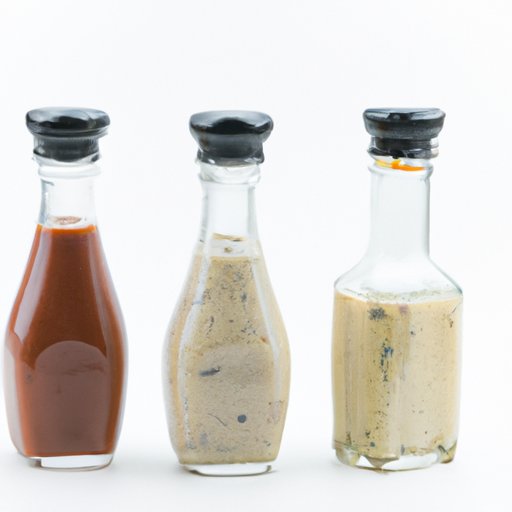
Introduction
The demand for gluten-free products has increased in recent years as more people have become aware of gluten sensitivity and celiac disease. Gluten-free diets have become a necessity for many people, and it is essential for them to ensure that the food they consume is gluten-free, including salad dressing. This article aims to provide a comprehensive guide on whether salad dressing is gluten-free and how to navigate the options available to meet your dietary needs.
Everything You Need to Know About Salad Dressing and Gluten-Free Options
Gluten is a protein found in grains such as wheat, barley, and rye. When people with gluten sensitivity consume gluten-containing foods, it triggers an immune response that leads to damage to the lining of the small intestine. This damage leads to malabsorption of nutrients, which results in various health problems. Therefore, people with gluten sensitivity or celiac disease need to follow a gluten-free diet, and salad dressing is no exception.
Navigating the Gluten-Free Salad Dressing Options
Reading labels and identifying gluten-free salad dressing can be overwhelming, but it’s crucial for people with gluten sensitivities. Reading labels is the first step to identify if salad dressing is gluten-free. A gluten-free labeled product means it has less than 20 parts per million (ppm) of gluten, which is safe for consumption for people with gluten sensitivities. However, it is essential to keep in mind that gluten-free labeling is voluntary, so it’s important to read the labels carefully.
Common glue-containing ingredients that may sneak into salad dressing include wheat, barley, rye, malt, wheat starch, and modified food starch. Other ingredients that may contain gluten include vinegar, soy sauce, and some types of spices. However, distilled vinegar is gluten-free since the distillation process removes the gluten-containing proteins.
Some types of salad dressing that are typically gluten-free include vinaigrettes, oil-based dressings, and those made with gluten-free ingredients such as lemon juice, herbs, and spices. It’s important to note that creamy dressings such as ranch and blue cheese may contain gluten, so it’s crucial to check the labels.
Why Salad Dressing May Not Be Safe for Gluten-Free Diets
Cross-contamination during manufacturing is a common reason why gluten-free salad dressing may not be safe for consumption. Cross-contamination occurs when gluten-containing products come into contact with gluten-free products during manufacturing or packaging, leading to gluten contamination. Other times, gluten-free labeled salad dressing may not meet the gluten-free standards set by regulatory agencies, leading to undetected gluten contamination.
The risks of consuming gluten-contaminated salad dressing for those with gluten sensitivities can be severe. Consuming gluten can cause various health problems, primarily gastrointestinal problems, including abdominal pain, bloating, diarrhea, and constipation. In severe cases, gluten consumption can trigger an immune response that leads to damage to the small intestine’s lining, causing malabsorption of nutrients.
5 Delicious Gluten-Free Salad Dressing Recipes to Try at Home
Making your own gluten-free salad dressing is easy and delicious. Here are five easy gluten-free salad dressing recipes you can try at home:
- Basic Vinaigrette– Mix olive oil, red wine vinegar, and garlic to make a basic gluten-free salad dressing.
- Lemon Vinaigrette– Mix olive oil, lemon juice, thyme, and honey to make a tangy and delicious salad dressing.
- Honey Mustard Dressing– Mix honey, dijon mustard, apple cider vinegar, and olive oil to create a creamy and sweet gluten-free salad dressing.
- Garlic and Herb Dressing– Mix olive oil, white wine vinegar, garlic, and dried herbs to make a savory salad dressing.
- Ginger Sesame Dressing– Mix olive oil, rice vinegar, sesame oil, and ginger to create an Asian-inspired gluten-free salad dressing.
The Best Store-Bought Gluten-Free Salad Dressing Brands
Thankfully, there are various trusted and recommended store-bought gluten-free salad dressing brands. Some of the popular gluten-free salad dressing brands include Tessemae’s, Primal Kitchen, and Annie’s Naturals. Tessemae’s offers various flavors of gluten-free salad dressing, including Lemon Garlic, Organic Balsamic, and Organic Ranch. Primal Kitchen offers Avocado Ranch, Greek Vinaigrette, and Citrus Miso dressing, among others. Annie’s Naturals offers various gluten-free dressings, including Organic Caesar Salad Dressing, Organic Green Garlic Dressing, and Organic Sesame Ginger Dressing.
What to Look for When Choosing Gluten-Free Salad Dressing
When buying gluten-free salad dressing, it’s crucial to keep the following in mind:
- Always read the labels carefully, even if the product is labeled gluten-free
- Avoid salad dressing with wheat, barley, rye, malt, wheat starch, or modified food starch.
- Choose salad dressing with natural ingredients such as herbs, spices, olive oil, and vinegar.
- Avoid any suspicious ingredients unless you can confirm they are gluten-free, such as soy sauce.
- If you are unsure if the salad dressing is gluten-free, contact the manufacturer for clarification.
Conclusion
In conclusion, it is essential to ensure that your salad dressing is gluten-free if you have gluten sensitivities or celiac disease. Reading labels, identifying gluten-free salad dressings, and making your dressing at home are the best ways to ensure that the salad dressings you consume are gluten-free. People with gluten sensitivities need to be vigilant when it comes to gluten-free diets, and being knowledgeable about the best gluten-free salad dressing options is a good place to start.





